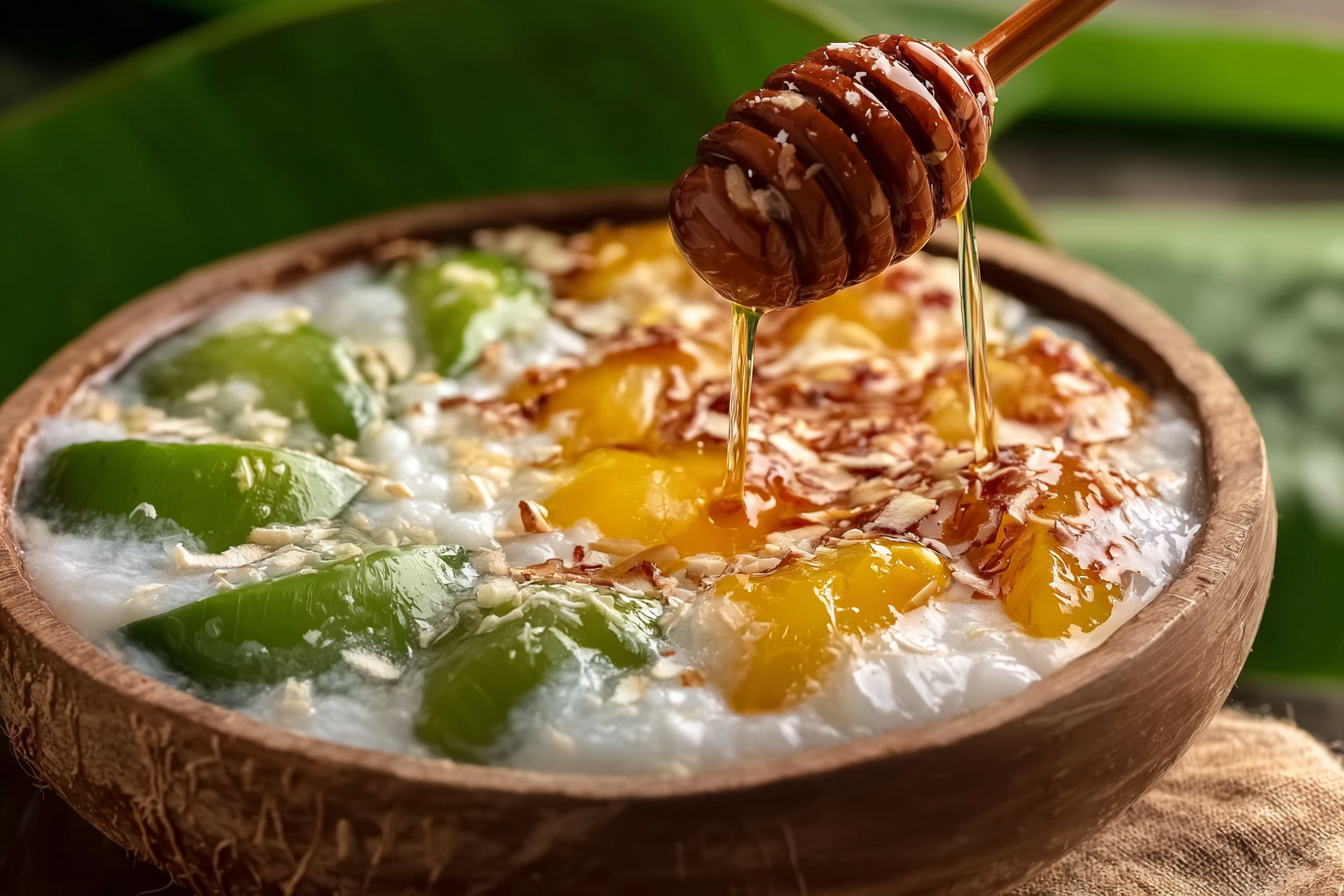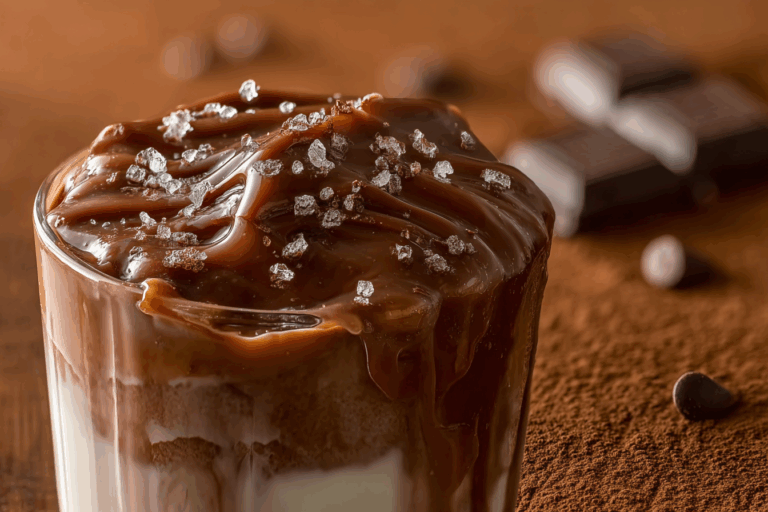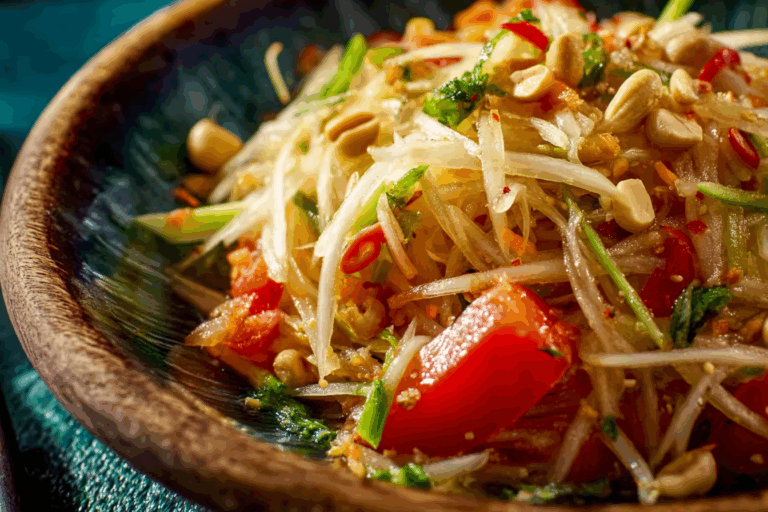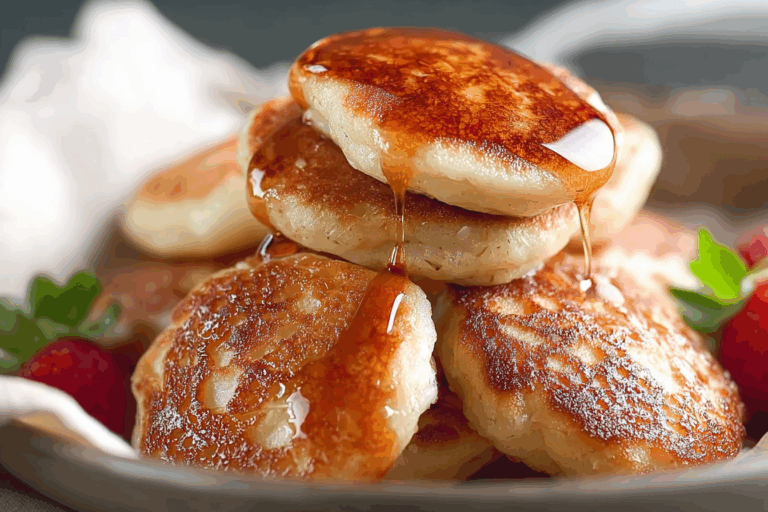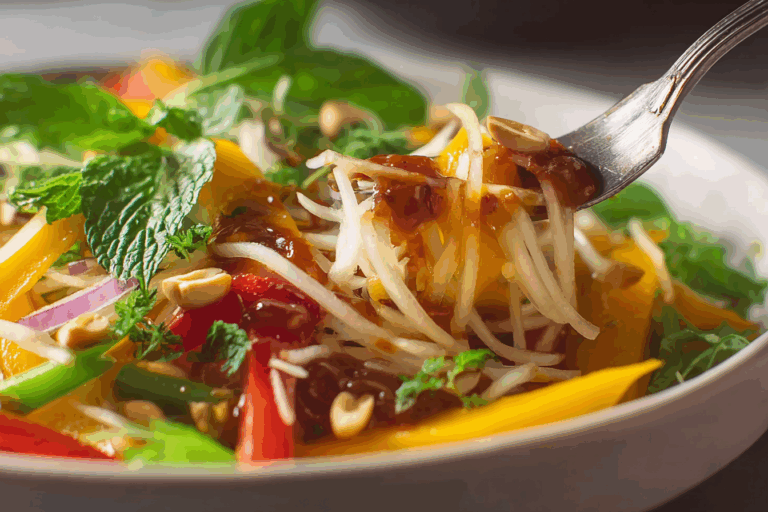Thai Lod Chong Dessert: Everything You Need to Know About This Thai Classic
Thai Lod Chong Dessert is more than just a treat; it’s a journey into the heart of Thailand’s culinary traditions. Here at Just Thai Recipes, our passion for Thai flavors began with Lina, our founder, who started this blog as a way to share her love for authentic Thai cooking. On our About page, Lina recalls wandering the vibrant markets of Bangkok, captivated by the colorful street food and the delicate aroma of pandan leaves drifting through the air.
This dessert, with its silky pandan noodles and creamy coconut milk, was one of the first Thai sweets she learned to make. Today, we’re inviting you to join us in exploring Thai Lod Chong Dessert in all its glory—its origins, ingredients, step-by-step preparation, and why it has become a summer favorite worldwide.
Whether you’re curious about its taste, seeking the best Thai Lod Chong dessert recipe, or wondering how it compares to other Thai sweets, this detailed guide covers it all. By the end, you’ll not only know how to make it but also understand why it’s one of Thailand’s most refreshing desserts.
Table of Contents
Table of Contents
What Is Thai Lod Chong Dessert?
The History and Origins of Thai Lod Chong
Thai Lod Chong Dessert is a traditional Thai sweet that has delighted generations. Known locally as “Lod Chong Nam Kathi,” this dessert is made of green pandan-flavored noodles swimming in creamy coconut milk, sweetened with a rich coconut sugar syrup, and served over crushed ice. Its name “Lod Chong” literally means “to pass through,” which refers to the process of pressing the soft dough through a sieve into ice water to form the signature worm-like noodles.
The dessert traces its roots back centuries, originating as a refreshing street food to combat Thailand’s tropical heat. Street vendors across Bangkok and rural provinces still serve it in small bowls or plastic bags filled with ice. Thai Lod Chong has close cousins across Southeast Asia, including Malaysia’s cendol and Indonesia’s dawet, yet its balance of slightly salted coconut milk and aromatic pandan sets it apart.
This isn’t just a dessert for tourists—it’s deeply woven into Thai culture. You’ll find Lod Chong served at local markets, temple fairs, and even family gatherings during Songkran (Thai New Year) as a way to cool off and enjoy a light, satisfying treat.
Key Features That Make Lod Chong Unique
What makes Thai Lod Chong Dessert truly special is its contrasting textures and flavors. The pandan noodles are soft yet slightly chewy, giving each spoonful a satisfying bite. The coconut milk is lightly salted to balance the sweetness of the coconut sugar syrup, creating a rich but refreshing flavor profile. The crushed ice adds another layer of coolness, making Lod Chong the ultimate antidote for sweltering summer days.
Its natural green hue, derived from fresh pandan leaves, means no artificial coloring is needed. Plus, this dessert is gluten-free and vegan-friendly by default, making it accessible to a wide range of dietary preferences. Whether you enjoy it plain or with toppings like jackfruit or sweet corn, Thai Lod Chong Dessert is a perfect representation of Thailand’s vibrant culinary identity.
Print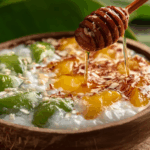
Thai Lod Chong Dessert: Everything You Need to Know About This Thai Classic
- Prep Time: 4 hours
- Cook Time: 45 minutes
- Total Time: 4 hours 45 minutes
- Yield: 6 servings 1x
- Category: Dessert
- Method: Stovetop
- Cuisine: Thai
- Diet: Vegan
Description
Thai Lod Chong is a refreshing traditional dessert made with vibrant green pandan noodles, sweet coconut syrup, and salted coconut milk. This chilled treat is perfect for hot days and loved across Southeast Asia for its chewy texture and creamy sweetness.
Ingredients
- 1 cup rice flour
- 5 tablespoons tapioca starch
- 3.5 ounces pandan leaves, chopped
- 5 cups water
- 3 tablespoons calcium hydroxide
- 2 cups coconut milk
- 1 teaspoon salt
- 2 pandan leaves
- 1 cup coconut sugar
- 1/2 cup water
Instructions
- Make limewater by stirring calcium hydroxide into water until dissolved. Let sit for 3 hours.
- Pour off 5 cups of the clear limewater, leaving sediment behind. Blend 4 cups with chopped pandan leaves. Save 1 cup limewater for later.
- Strain blended pandan water through cheesecloth into a bowl.
- Mix tapioca starch and rice flour in a large bowl. Gradually knead in strained pandan water to form dough.
- Transfer mixture to a pot over low heat. Stir continuously until it thickens, about 10 minutes.
- Add the reserved cup of limewater a little at a time every 3 minutes while stirring constantly for 30 minutes. The mixture should turn bright green and gooey.
- Press the dough through a lod chong press into ice-cold water to form noodles.
- For sugar syrup: Simmer coconut sugar and water in a saucepan over medium heat for 3–5 minutes until slightly thickened.
- For coconut milk: Heat coconut milk, salt, and pandan leaves in a saucepan over low heat for about 3 minutes.
- Drain pandan noodles. To serve, place ice in a bowl, add noodles, pour over coconut milk and syrup, and top with optional jackfruit or corn.
Notes
- Use fresh pandan leaves for the most vibrant color and flavor.
- If you don’t have a lod chong press, use a potato ricer with large holes.
- Serve immediately for best texture and freshness.
- Add toppings like sweetened jackfruit, palm seeds, or young coconut for variety.
Nutrition
- Serving Size: 1 bowl
- Calories: 310
- Sugar: 25g
- Sodium: 150mg
- Fat: 12g
- Saturated Fat: 10g
- Unsaturated Fat: 1g
- Trans Fat: 0g
- Carbohydrates: 48g
- Fiber: 1g
- Protein: 2g
- Cholesterol: 0mg
Keywords: Thai Lod Chong, pandan noodles, Thai dessert, coconut milk dessert, Southeast Asian dessert
Thai Lod Chong Dessert Ingredients Breakdown
Essential Ingredients and Their Roles
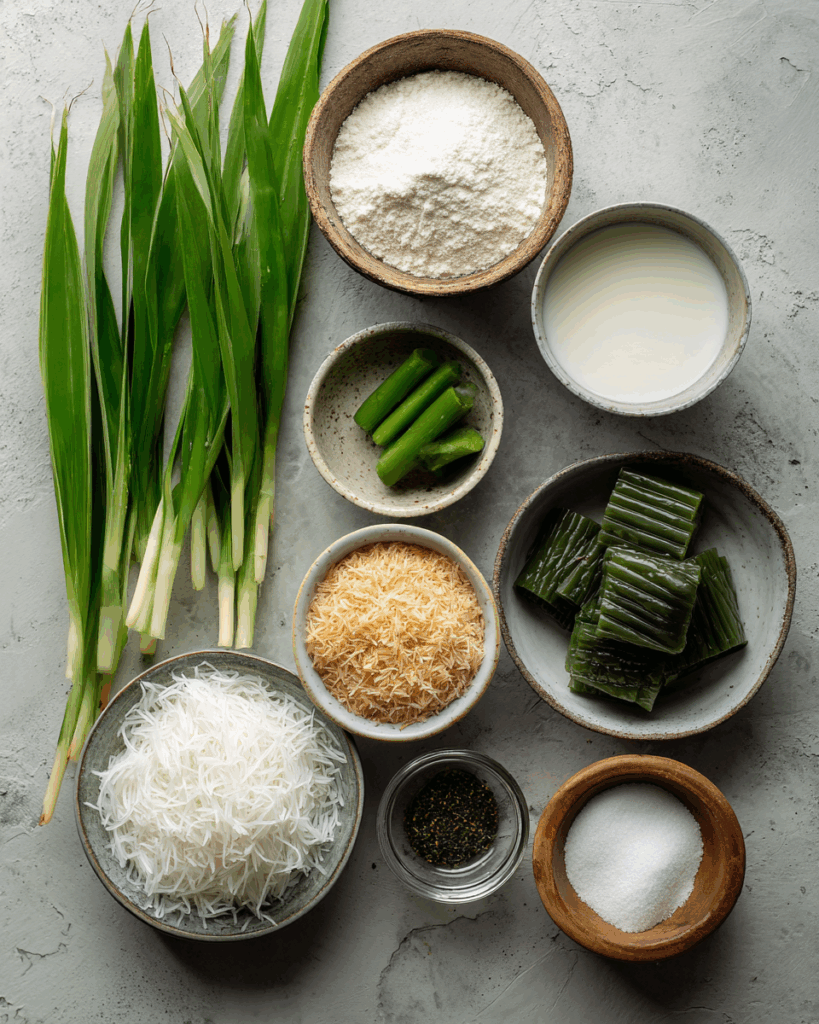
The charm of Thai Lod Chong Dessert lies in its simplicity, using natural ingredients that bring a harmony of flavors and textures. To make an authentic version at home, you’ll need three key components: pandan noodles, salted coconut milk, and coconut sugar syrup.
Pandan Noodles
These are the heart of the dessert, giving it its vibrant green color and unique texture.
- Rice flour (1 cup): Provides the base structure for the noodles, keeping them soft yet slightly chewy.
- Tapioca starch (5 tablespoons): Adds elasticity and helps achieve that satisfying springy bite.
- Pandan leaves (3.5 ounces, chopped): Fresh leaves give a sweet, grassy aroma and natural coloring.
- Calcium hydroxide (3 tablespoons): Used to make limewater, which helps strengthen the noodles so they hold their shape when pressed into ice water.
- Water (5 cups): Essential for blending the pandan leaves and making limewater.
Salted Coconut Milk
This creamy base balances the dessert’s sweetness perfectly.
- Coconut milk (2 cups): Adds rich, velvety texture. Opt for full-fat coconut milk for the best flavor.
- Salt (1 teaspoon): A small amount enhances the sweetness of the dessert without making it salty.
- Pandan leaves (2): Simmered in coconut milk for added aroma.
Coconut Sugar Syrup
This syrup provides a mild caramel flavor that ties the dessert together.
- Coconut sugar (1 cup): Has a deep, molasses-like taste that is less overpowering than refined sugar.
- Water (1/2 cup): Helps dissolve the sugar and create a pourable syrup.
Together, these ingredients create a dessert that is as visually stunning as it is flavorful.
Why Pandan Leaves Are the Star of the Show
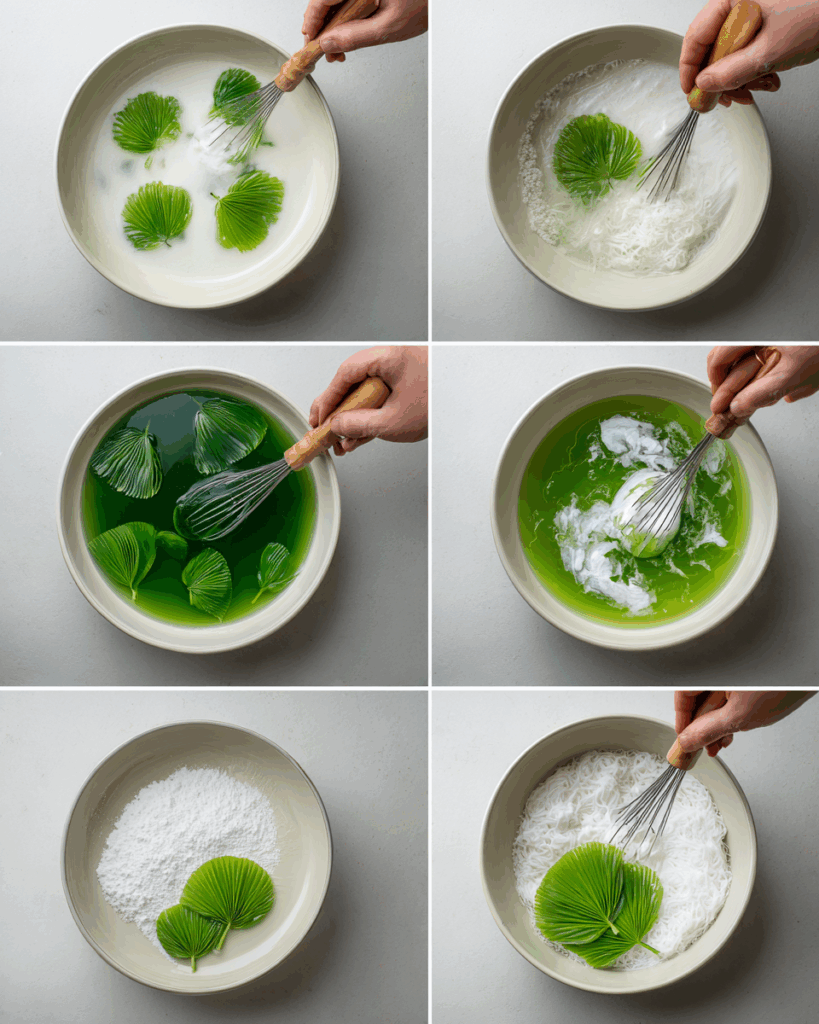
Pandan leaves are more than just a natural coloring agent—they are the soul of Thai Lod Chong Dessert. Their aroma is often described as a mix of vanilla, almond, and fresh grass, infusing the noodles and coconut milk with a scent that instantly transports you to a Thai kitchen.
To extract their flavor, the leaves are blended with limewater and strained, resulting in a bright green liquid that’s mixed with the flour to create the dough. This step is crucial because it’s what sets Thai Lod Chong apart from similar desserts. Learn more about pandan leaves’ role in Thai cooking in our guide to Thai Red Rubies Dessert and see how they elevate a variety of traditional sweets.
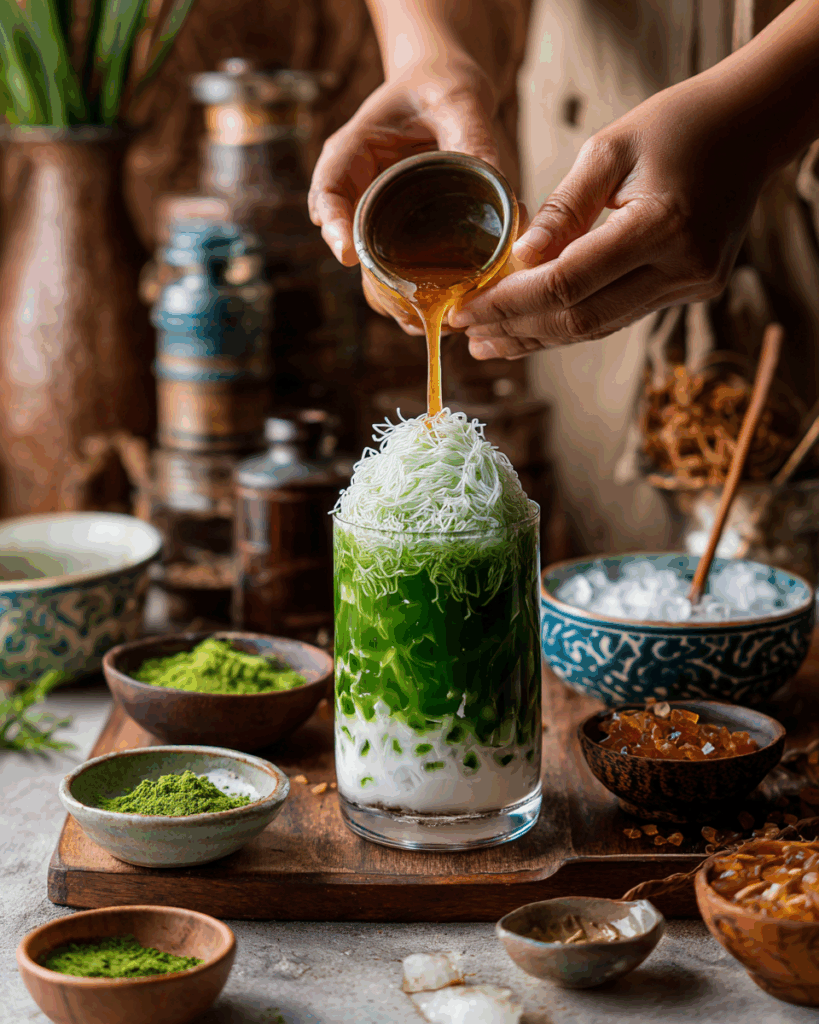
Serving Thai Lod Chong Like a Pro
Assembling the Dessert
Now that all the components are ready, it’s time to assemble Thai Lod Chong Dessert into the refreshing, colorful masterpiece it’s known for.
- Drain the Pandan Noodles
- Take the noodles out of the ice water using a strainer. Let them sit for a moment to remove excess water.
- Layer the Ingredients
- In a serving bowl or glass, add a generous scoop of crushed ice.
- Top with a portion of pandan noodles.
- Pour over enough salted coconut milk to just cover the noodles.
- Drizzle with the rich coconut sugar syrup, adjusting the amount to your preferred sweetness.
- Optional Toppings
- Add slices of fresh jackfruit, sweet corn kernels, or even red rubies (water chestnuts coated in tapioca) for extra texture and flavor.
Presentation Tips to Impress Your Guests
For a more elegant presentation, serve Thai Lod Chong Dessert in clear glass bowls or parfait glasses to showcase the vibrant green noodles and creamy layers. Garnish with a small pandan leaf or a slice of tropical fruit for a touch of authenticity.
If you’re curious about more creative Thai dessert presentations, check out this excellent resource on traditional Thai dessert plating techniques from TasteAtlas and discover why visual appeal plays such a big role in Thai sweets.
Thai Lod Chong Dessert vs. Other Thai Sweets
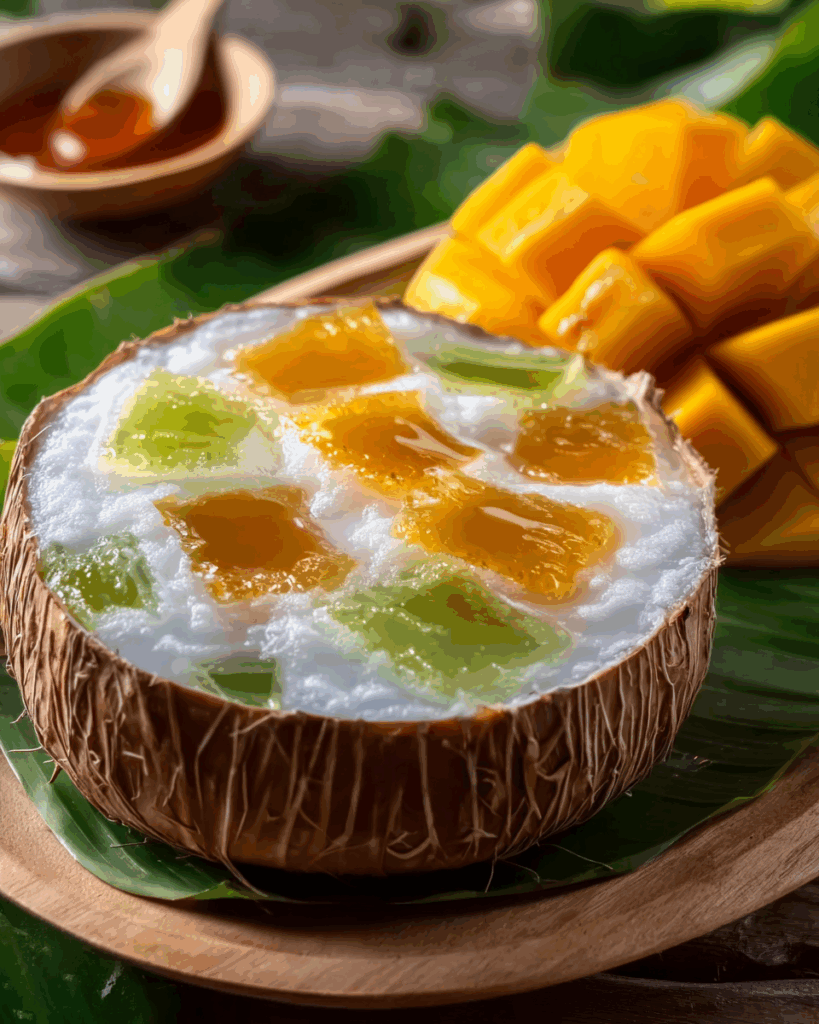
Comparing Lod Chong and Luk Chup
Thailand’s dessert culture is as diverse as its street food, and two of its most colorful offerings are Lod Chong and Luk Chup.
Lod Chong is a chilled dessert made with pandan noodles, coconut milk, and coconut sugar syrup served over crushed ice. Its appeal lies in its balance of creamy, mildly sweet flavors and the refreshing sensation it offers on a hot day.
Luk Chup, on the other hand, is an artistic sweet crafted from mung bean paste. Shaped and painted to resemble miniature fruits and vegetables, these delicate treats are glazed for a glossy finish. While Luk Chup is visually stunning and often served at special occasions or as gifts, it’s less of a refreshing dessert and more of a snack to savor slowly.
Thai Lod Chong vs. Cendol: What’s the Difference?
It’s common to compare Thai Lod Chong Dessert with cendol, a similar dessert popular in Malaysia and Indonesia. Both feature pandan-flavored noodles and coconut milk, but the differences are significant:
| Feature | Thai Lod Chong Dessert | Malaysian Cendol |
|---|---|---|
| Noodle Texture | Soft and slightly chewy | Firmer and slightly thicker |
| Sweetener Used | Coconut sugar syrup | Palm sugar syrup (gula melaka) |
| Coconut Milk Flavor | Lightly salted, mild | Richer, sometimes thicker |
| Additional Toppings | Jackfruit, corn, red rubies | Red beans, grass jelly, sweet corn |
Health Benefits and Nutritional Value
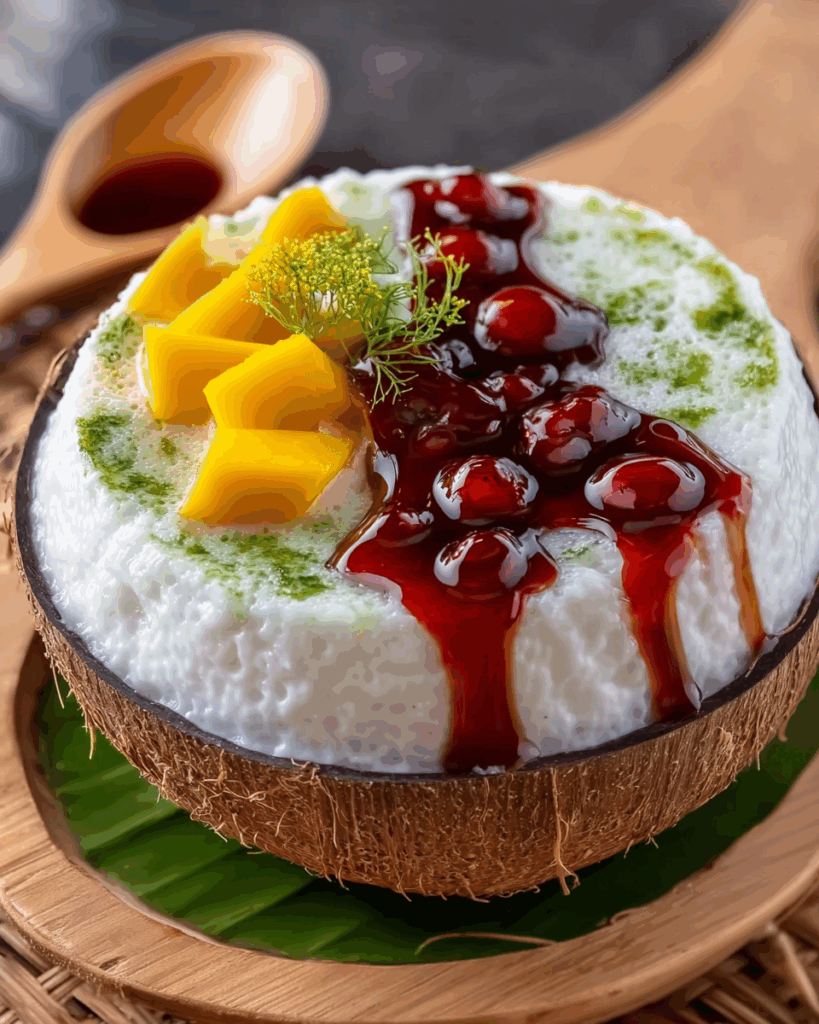
Is Thai Lod Chong a Healthy Dessert Option?
Thai Lod Chong Dessert may be indulgent, but it’s lighter and more natural than many Western-style sweets. The use of coconut milk provides healthy fats known as medium-chain triglycerides (MCTs), which are easily metabolized for energy. Pandan leaves, aside from their aromatic qualities, have been used in traditional Thai remedies for their antioxidant properties.
Coconut sugar, while still a form of sugar, has a lower glycemic index compared to refined white sugar, meaning it causes a slower rise in blood sugar levels. The dessert’s minimal use of processed ingredients and the inclusion of plant-based elements make it a comparatively wholesome choice when enjoyed in moderation.
Adapting the Recipe for Vegan or Gluten-Free Diets
Thai Lod Chong is naturally gluten-free since it uses rice flour and tapioca starch for the noodles. It’s also vegan by default, as the creaminess comes from coconut milk rather than dairy. For those seeking an even lighter option, you can use a reduced-fat coconut milk or substitute part of the coconut milk with almond milk for a milder flavor while maintaining a creamy texture.
Where to Find Thai Lod Chong Dessert Near You
Popular Thai Restaurants Serving Lod Chong
This dessert has gained popularity far beyond Thailand’s borders, and it’s now featured on the menus of many Thai restaurants around the world. In urban areas with a strong Thai community, you may also find it sold at dessert shops and food courts specializing in Southeast Asian cuisine.
For those who live in smaller towns or areas with fewer Thai restaurants, Asian grocery stores often carry ready-made pandan noodles or even frozen versions of Lod Chong that can be assembled at home with fresh coconut milk and syrup.
Making It at Home vs. Buying It
While it’s convenient to enjoy Thai Lod Chong Dessert at a restaurant, making it at home gives you complete control over the ingredients and sweetness level. It also allows you to add personal touches, like unique toppings or adjusting the coconut milk’s saltiness to suit your palate. Homemade versions often taste fresher and are more rewarding, especially when shared with friends and family.
Related Thai Desserts You’ll Love
Thai Red Rubies Dessert: A Crunchy and Colorful Delight
This dessert features crunchy water chestnuts coated in vibrant red tapioca pearls, served in chilled coconut milk. It’s a textural contrast to Lod Chong and equally refreshing.
Thai Mango Sticky Rice: The Tropical Classic
A timeless favorite, Mango Sticky Rice pairs sweet, ripe mango slices with sticky glutinous rice drenched in coconut cream. It’s a perfect dessert for mango lovers and a staple in Thai culinary culture.
Coconut Jelly: A Light Alternative
For a lighter dessert option, Coconut Jelly offers a delicate coconut flavor with a soft, wobbly texture, making it an excellent choice for those who prefer milder sweets.
Mastering Thai Lod Chong Dessert at Home – Pro Tips and Variations
Expert Tips for Perfect Pandan Noodles Every Time
Making pandan noodles can seem intimidating at first, but a few expert techniques make the process easier and more consistent:
- Control the Heat Carefully
Keep the mixture over low heat and stir constantly to prevent lumps. High heat can cause uneven cooking and make the noodles grainy instead of smooth. - Use Fresh Pandan Leaves
For the most vibrant green color and aromatic flavor, use fresh pandan leaves rather than frozen or bottled pandan extract. Fresh leaves yield a more natural sweetness and brighter hue. - Invest in a Lod Chong Press
A traditional Lod Chong press will give you the characteristic worm-like shape and texture. If you don’t have one, a potato ricer or even a piping bag with a large round nozzle can work as substitutes. - Ice Bath Is Non-Negotiable
Plunging the noodles immediately into ice-cold water after pressing helps them set and prevents sticking. Skipping this step can leave you with a mushy texture.
Creative Variations of Thai Lod Chong Dessert
Once you master the classic recipe, try these fun variations to add a modern twist to this traditional dessert:
- Fruity Fusion
Add cubes of ripe mango, lychee, or longan for a burst of tropical sweetness. These fruits pair beautifully with the coconut milk base. - Chocolate Lod Chong
Mix a little cocoa powder into the pandan dough for a unique chocolate-pandan fusion dessert. - Color Play
Use natural food colors like butterfly pea flower for blue noodles or beetroot juice for pink ones, creating a rainbow version that’s especially popular with kids. - Warm Version for Cool Days
Instead of serving over ice, pour the salted coconut milk and syrup over warm pandan noodles. This cozy variation is comforting during cooler weather or rainy seasons.
Why Homemade Is Worth the Effort
Making Thai Lod Chong Dessert at home not only gives you control over ingredient quality and sweetness level but also provides an authentic connection to Thai culinary traditions. The process of creating each component from scratch can be deeply satisfying and rewarding, making the dessert taste even better.
The Cultural Significance of Thai Lod Chong Dessert
Lod Chong as a Symbol of Thai Hospitality
In Thailand, desserts are more than just sweet treats—they’re expressions of care and generosity. Thai Lod Chong Dessert embodies this spirit of hospitality. Often served at family gatherings, temple fairs, and neighborhood events, it’s a way for hosts to refresh guests during the country’s sweltering heat. The use of natural ingredients like pandan and coconut also reflects Thailand’s deep connection to its tropical landscape and agricultural roots.
Festivals and Celebrations Featuring Lod Chong
Thai Lod Chong Dessert makes frequent appearances during Songkran, the Thai New Year festival held in April. Songkran is synonymous with water fights and cooling off, and no dessert fits the occasion better than Lod Chong served over ice. It’s also a popular choice at Loy Krathong, the festival of lights, where locals float small banana-leaf boats decorated with flowers and candles on rivers. Street vendors set up stalls offering refreshing bowls of Lod Chong to festival-goers, making it part of the culinary fabric of these celebrations.
A Dessert Passed Down Through Generations
Many Thai families have their own recipes for Lod Chong, often passed down through generations. Grandparents teach younger family members how to extract pandan juice, stir the dough patiently, and perfect the noodle texture. Making this dessert is as much about preserving culture as it is about satisfying a sweet tooth.
Modern Takes on Thai Lod Chong Dessert in Today’s Culinary Scene
Lod Chong in Contemporary Thai Cafés and Restaurants
In recent years, Thai Lod Chong Dessert has undergone a renaissance in Thailand’s bustling café culture and fine dining restaurants. Chefs and dessert artisans have started reimagining this traditional treat in new and exciting ways while preserving its core flavors.
Trendy dessert shops now serve Lod Chong in tall glasses layered like parfaits, with additions like chia seeds, basil seeds, and even scoops of coconut or matcha ice cream. Some high-end restaurants plate Lod Chong as a deconstructed dessert, with the pandan noodles, coconut milk foam, and coconut sugar caramel artfully arranged on modern ceramic dishes.
Creative Global Twists on Lod Chong
Outside Thailand, chefs in cities like New York, London, and Sydney are adapting Thai Lod Chong Dessert for a global audience. Versions with almond or oat milk cater to plant-based diners, while others incorporate flavors like espresso or vanilla bean for a fusion dessert that bridges East and West.
Even bubble tea shops have started experimenting by adding Lod Chong noodles as a topping in place of tapioca pearls, offering a unique chewy texture alongside their signature drinks.
Why Lod Chong Remains Timeless Despite Innovations
While these modern takes bring fresh attention to Thai Lod Chong Dessert, the traditional version remains timeless. Its simplicity, natural ingredients, and nostalgic flavor ensure it will never lose its place in Thai homes and street food culture. Innovations might draw new fans, but the essence of Lod Chong—pandan, coconut, and ice—continues to define it.
Conclusion
Thai Lod Chong Dessert is more than just a sweet—it’s a cultural icon, a culinary masterpiece, and a refreshing symbol of Thailand’s rich food heritage. From its origins in Thai street markets to its modern twists in trendy cafés, Lod Chong continues to delight people with its tender pandan noodles, creamy coconut milk, and rich coconut sugar syrup.
Whether you prepare it at home using our detailed step-by-step guide or seek it out at a local Thai restaurant, this dessert promises a sensory journey through Thailand’s flavors. It’s light, naturally plant-based, and endlessly adaptable—perfect for both traditionalists and adventurous food lovers.
Now that you’ve explored the story, ingredients, preparation, and modern innovations of Thai Lod Chong Dessert, it’s your turn to try making it. Gather your ingredients, set aside some time, and bring a taste of Thailand right into your kitchen.
And if you’re still curious about Thai cuisine’s vibrant dessert culture, don’t miss our guides to Thai Mango Sticky Rice and Thai Red Rubies Dessert—they’re equally irresistible.
FAQs About Thai Lod Chong Dessert
What is Luk Chup Thai dessert?
Luk Chup is a colorful Thai dessert made from mung bean paste, shaped and painted to look like miniature fruits and vegetables. Each piece is coated in a shiny glaze, making it as much a visual treat as a flavorful one. Unlike Lod Chong, which is served cold, Luk Chup is more of a bite-sized snack meant to be savored slowly.
What does Lod Chong taste like?
Lod Chong has a subtle, fragrant flavor with earthy notes from pandan leaves, balanced by the creamy richness of coconut milk and a hint of caramel-like sweetness from coconut sugar syrup. It’s mildly sweet, slightly salty, and incredibly refreshing thanks to the crushed ice.
What is the most popular dessert in Thailand?
Mango Sticky Rice is often considered the most popular Thai dessert due to its seasonal appeal and wide recognition worldwide. However, Thai Lod Chong is equally loved for its light and cooling qualities, making it a go-to during Thailand’s sweltering summers.
What is Thai Lod Chong?
Thai Lod Chong is a traditional Thai dessert featuring soft, green pandan-flavored noodles served in a bowl of lightly salted coconut milk and sweetened coconut sugar syrup over crushed ice. It’s a refreshing treat perfect for hot weather and is commonly enjoyed as street food across Thailand.

